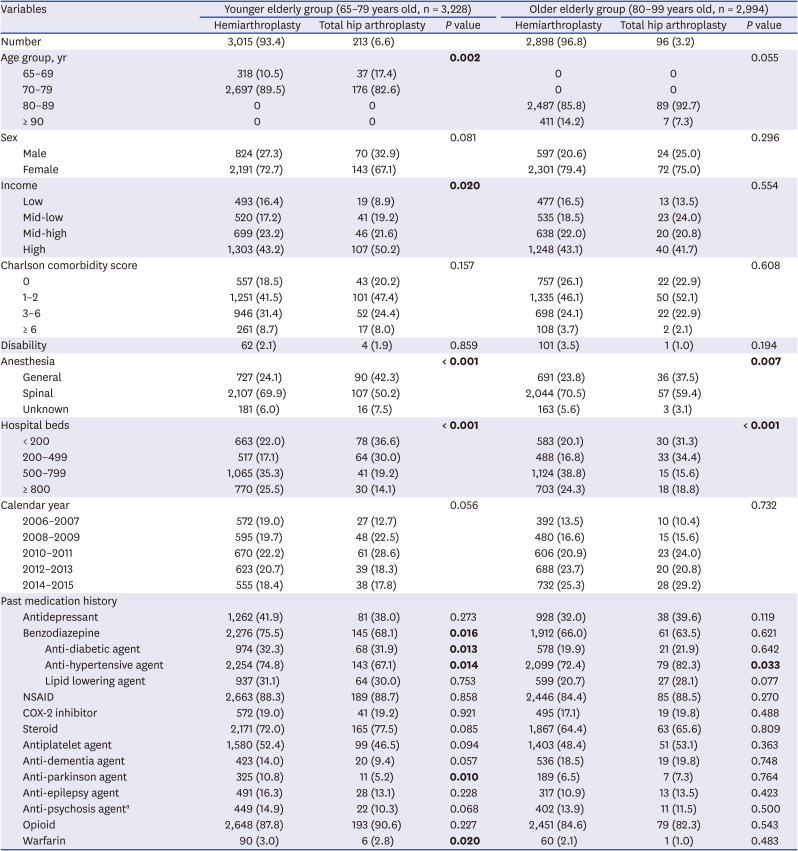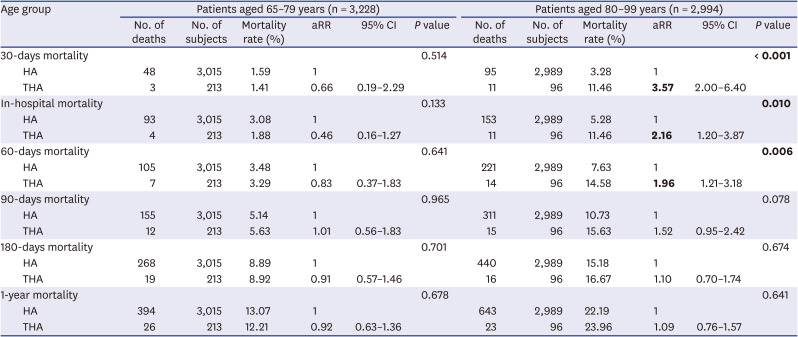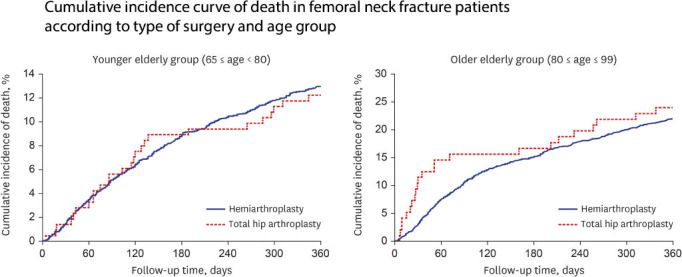1. Kannan A, Kancherla R, McMahon S, Hawdon G, Soral A, Malhotra R. Arthroplasty options in femoral-neck fracture: answers from the national registries. Int Orthop. 2012; 36(1):1–8. PMID:
21931966.

2. Bhandari M, Devereaux PJ, Tornetta P 3rd, Swiontkowski MF, Berry DJ, Haidukewych G, et al. Operative management of displaced femoral neck fractures in elderly patients. An international survey. J Bone Joint Surg Am. 2005; 87(9):2122–2130. PMID:
16140828.
3. Parker M. Total hip arthroplasty versus hemiarthroplasty for intracapsular hip fractures. Bone Joint J. 2021; 103-B(1):3–4.

4. HEALTH Investigators. Bhandari M, Einhorn TA, Guyatt G, Schemitsch EH, Zura RD, et al. Total hip arthroplasty or hemiarthroplasty for hip fracture. N Engl J Med. 2019; 381(23):2199–2208. PMID:
31557429.

5. Sharkey PF, Rao R, Hozack WJ, Rothman RH, Carey C. Conversion of hemiarthroplasty to total hip arthroplasty: can groin pain be eliminated? J Arthroplasty. 1998; 13(6):627–630. PMID:
9741437.
6. Eskildsen SM, Kamath GV, Del Gaizo DJ. Age matters when comparing hemiarthroplasty and total hip arthroplasty for femoral neck fractures in Medicare patients. Hip Int. 2019; 29(6):674–679. PMID:
30526123.

7. Ravi B, Pincus D, Khan H, Wasserstein D, Jenkinson R, Kreder HJ. Comparing complications and costs of total hip arthroplasty and hemiarthroplasty for femoral neck fractures: a propensity score-matched, population-based study. J Bone Joint Surg Am. 2019; 101(7):572–579. PMID:
30946190.
8. Wang F, Zhang H, Zhang Z, Ma C, Feng X. Comparison of bipolar hemiarthroplasty and total hip arthroplasty for displaced femoral neck fractures in the healthy elderly: a meta-analysis. BMC Musculoskelet Disord. 2015; 16(1):229. PMID:
26316274.

9. Barışhan FC, Akesen B, Atıcı T, Durak K, Bilgen MS. Comparison of hemiarthroplasty and total hip arthroplasty in elderly patients with displaced femoral neck fractures. J Int Med Res. 2018; 46(7):2717–2730. PMID:
29708038.

10. Moerman S, Mathijssen NM, Tuinebreijer WE, Vochteloo AJ, Nelissen RG. Hemiarthroplasty and total hip arthroplasty in 30,830 patients with hip fractures: data from the Dutch arthroplasty register on revision and risk factors for revision. Acta Orthop. 2018; 89(5):509–514. PMID:
30080985.

11. Khan AM, Rafferty M, Daurka JS. Hemiarthroplasty compared with total hip arthroplasty in fractured neck of femur: a shift in national practice? Ann R Coll Surg Engl. 2019; 101(2):86–92. PMID:
30112942.

12. Tol MC, van den Bekerom MP, Sierevelt IN, Hilverdink EF, Raaymakers EL, Goslings JC. Hemiarthroplasty or total hip arthroplasty for the treatment of a displaced intracapsular fracture in active elderly patients: 12-year follow-up of randomised trial. Bone Joint J. 2017; 99-B(2):250–254. PMID:
28148669.
13. Guyen O. Hemiarthroplasty or total hip arthroplasty in recent femoral neck fractures? Orthop Traumatol Surg Res. 2019; 105(1S):S95–101. PMID:
30449680.

14. Lewis DP, Wæver D, Thorninger R, Donnelly WJ. Hemiarthroplasty vs total hip arthroplasty for the management of displaced neck of femur fractures: a systematic review and meta-analysis. J Arthroplasty. 2019; 34(8):1837–1843.e2. PMID:
31060915.

15. Wang Z, Bhattacharyya T. Outcomes of hemiarthroplasty and total hip arthroplasty for femoral neck fracture: a Medicare cohort study. J Orthop Trauma. 2017; 31(5):260–263. PMID:
28431409.

16. Parker MJ, Gurusamy KS, Azegami S. Arthroplasties (with and without bone cement) for proximal femoral fractures in adults. Cochrane Database Syst Rev. 2010; (6):CD001706. PMID:
20556753.

17. Christensen K, Doblhammer G, Rau R, Vaupel JW. Ageing populations: the challenges ahead. Lancet. 2009; 374(9696):1196–1208. PMID:
19801098.

18. Burgers PT, Van Geene AR, Van den Bekerom MP, Van Lieshout EM, Blom B, Aleem IS, et al. Total hip arthroplasty versus hemiarthroplasty for displaced femoral neck fractures in the healthy elderly: a meta-analysis and systematic review of randomized trials. Int Orthop. 2012; 36(8):1549–1560. PMID:
22623062.

19. Harris IA, Cuthbert A, de Steiger R, Lewis P, Graves SE. Practice variation in total hip arthroplasty versus hemiarthroplasty for treatment of fractured neck of femur in Australia. Bone Joint J. 2019; 101-B(1):92–95. PMID:
30601055.

20. Seong SC, Kim YY, Park SK, Khang YH, Kim HC, Park JH, et al. Cohort profile: the National Health Insurance Service-National Health Screening Cohort (NHIS-HEALS) in Korea. BMJ Open. 2017; 7(9):e016640.

21. Lee J, Lee JS, Park SH, Shin SA, Kim K. Cohort profile: the National Health Insurance Service-National Sample Cohort (NHIS-NSC), South Korea. Int J Epidemiol. 2017; 46(2):e15. PMID:
26822938.

22. Lee YK, Ha YC, Choi HJ, Jang S, Park C, Lim YT, et al. Bisphosphonate use and subsequent hip fracture in South Korea. Osteoporos Int. 2013; 24(11):2887–2892. PMID:
23681088.

23. Quan H, Sundararajan V, Halfon P, Fong A, Burnand B, Luthi JC, et al. Coding algorithms for defining comorbidities in ICD-9-CM and ICD-10 administrative data. Med Care. 2005; 43(11):1130–1139. PMID:
16224307.

24. Cha YH, Ha YC, Yoo JI, Min YS, Lee YK, Koo KH. Effect of causes of surgical delay on early and late mortality in patients with proximal hip fracture. Arch Orthop Trauma Surg. 2017; 137(5):625–630. PMID:
28321571.

25. Maceroli MA, Nikkel LE, Mahmood B, Elfar JC. Operative mortality after arthroplasty for femoral neck fracture and hospital volume. Geriatr Orthop Surg Rehabil. 2015; 6(4):239–245. PMID:
26623156.

26. Shervin N, Rubash HE, Katz JN. Orthopaedic procedure volume and patient outcomes: a systematic literature review. Clin Orthop Relat Res. 2007; 457(457):35–41. PMID:
17415062.
27. Doro C, Dimick J, Wainess R, Upchurch G, Urquhart A. Hospital volume and inpatient mortality outcomes of total hip arthroplasty in the United States. J Arthroplasty. 2006; 21(6):Suppl 2. 10–16. PMID:
16950056.

28. Woon CY, Moretti VM, Schwartz BE, Goldberg BA. Total hip arthroplasty and hemiarthroplasty: US national trends in the treatment of femoral neck fractures. Am J Orthop (Belle Mead NJ). 2017; 46(6):E474–E478. PMID:
29309466.
29. Bhandari M, Devereaux PJ, Swiontkowski MF, Tornetta P 3rd, Obremskey W, Koval KJ, et al. Internal fixation compared with arthroplasty for displaced fractures of the femoral neck. A meta-analysis. J Bone Joint Surg Am. 2003; 85(9):1673–1681. PMID:
12954824.
30. Schneppendahl J, Grassmann JP, Petrov V, Böttner F, Körbl B, Hakimi M, et al. Decreasing mortality after femoral neck fracture treated with bipolar hemiarthroplasty during the last twenty years. Int Orthop. 2012; 36(10):2021–2026. PMID:
22740187.







 PDF
PDF Citation
Citation Print
Print




 XML Download
XML Download